Donor stewardship helps your organization build ongoing relationships with your donors by showing appreciation for their gift. While individuals are the primary source of fundraising for nonprofits, recent trends indicate a decline in giving. Therefore, retaining your current donor base is crucial.
Use this donor stewardship guide to develop the best stewardship plan for your nonprofit organization.
- About donor stewardship programs
- The donor pyramid and lifecycle
- The donor stewardship process
- Donor stewardship techniques
- Donor stewardship program roles and responsibilities
- Donor stewardship tools
- Stewardship plan guidelines
- Creating a stewardship plan
About donor stewardship programs
A donor stewardship program for nonprofits is a strategic and ongoing process of nurturing relationships with your donors to ensure their continued engagement, support, and loyalty. It encompasses a range of activities aimed at building meaningful connections with donors, acknowledging their contributions, and demonstrating the impact of their support.
This involves personalized communication, expressing gratitude for your donors’ gifts, providing updates on your organization’s work, and offering opportunities for donors to further engage with your cause. Effective donor stewardship fosters trust, strengthens donor relationships, and ultimately drives long-term sustainability for your nonprofit.
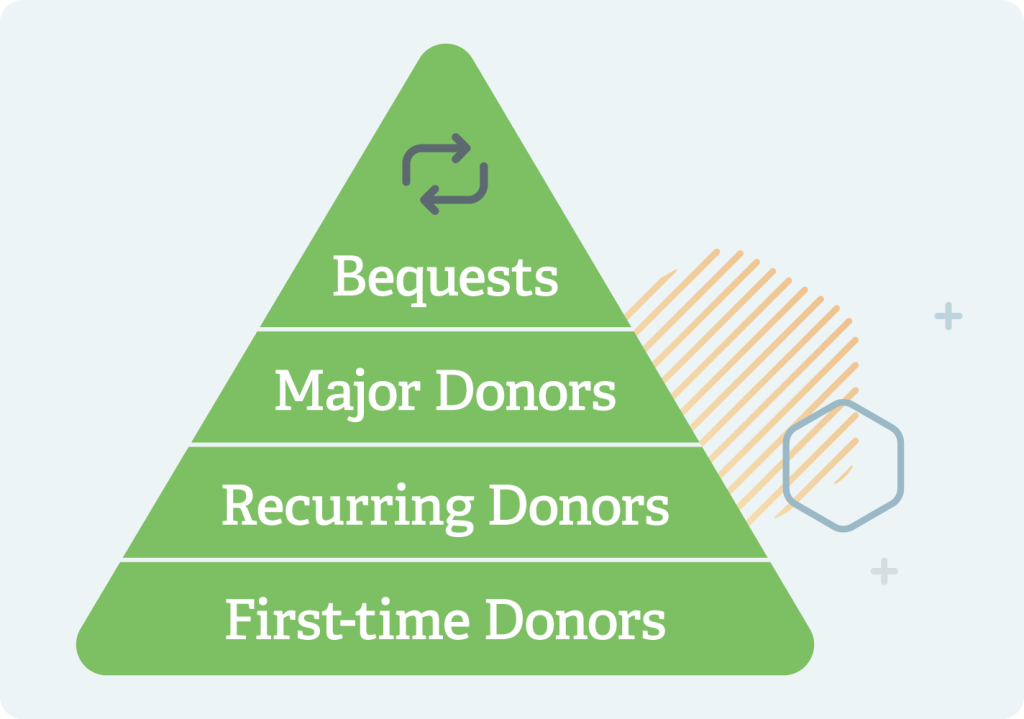
The donor pyramid and lifecycle
The donor pyramid
The donor pyramid is a means of visualizing the composition of your donors. Depending on your organization’s size, your pyramid may look different from other organizations’ pyramids. The image above shows an example of a common donor pyramid structure which includes bequests at the top, then major donors, recurring donors, and first-time donors at the bottom.
Typically, you’ll have more first-time donors than recurring donors, and so on. Therefore, your stewardship goal should be to move donors up the pyramid. That way, you’re not only retaining donors but also increasing their value to your organization. Remember, the donor pyramid is a concept to guide stewardship rather than a hard-and-fast rule.
What is the purpose of the donor pyramid?
The donor pyramid helps you understand the disbursement of your donors based upon their value to your organization. In general, you can use the pyramid to target segments of your supporters with certain stewardship techniques. These techniques should be designed to move your donors up the pyramid, thus increasing their value.
The pyramid is a tool for analyzing your donors in very general groups. To create the most personalized stewardship techniques, segment your donors even further within your pyramid.
What kind of donor pyramid should you create?
Your pyramid will depend on your nonprofit’s donor data. Most donor bases don’t split into a perfect pyramid shape. Determine how you’d like to define your broad donor categories by gift amounts.
Then, further segment your donors in different increments, such as the frequency of their gifts. These broad categories will determine the visual layout of your donors.
Ultimately, the “pyramid” is a concept more than a shape. Your pyramid should change as you focus on transitioning your donors upward.
How can you use the donor pyramid?
Your donor pyramid is a model that can help you better understand how and when your donors transition to higher giving levels. It shows where your organization is so you can craft a targeted strategy to improve your stewardship. For example, you can pair your pyramid with a timeline that demonstrates how long it took your donors, on average, to reach their current levels.
For instance, you may discover that it takes 5 years on average for your small donors to transition to mid-level donors. You can use that information to craft a targeted stewardship strategy by assessing your past stewardship efforts and utilizing that information to set new stewardship goals, such as a transition timeframe of 3 years.
This example shows how you can use the donor pyramid to assess your nonprofit’s current standing and set reasonable, data-driven stewardship goals.
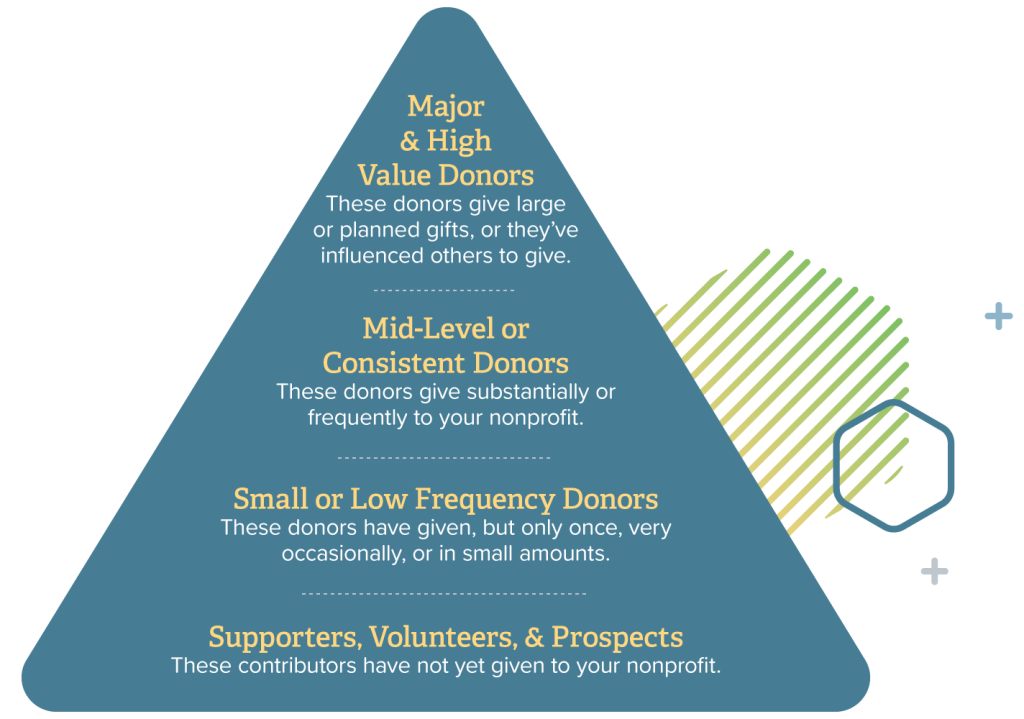
What kind of donor groups should you target?
Your strategy will depend on your organization, but these donor groups can be a strong place to start:
- Transitional Donors: These donors are usually loyal mid-level donors with greater giving potential. They are transitional because they slowly increase their gift size or have given consistently. You can speed up the process by paying these donors special attention.
- New Donors: All donors are valuable to your organization, and stewarding new donors is vital for retaining them. The more specific your new donor stewardship strategy is, the better. Even a $20 online gift warrants an email acknowledgment with opportunities for further engagement or upcoming events.
- Major Donors: Major donors are already at the top of the pyramid, but you still need to steward them to maintain and increase their current giving. Most stewardship efforts are concentrated on these donors—however, ensure your organization recognizes the value of high-level stewardship to other donor groups as well.
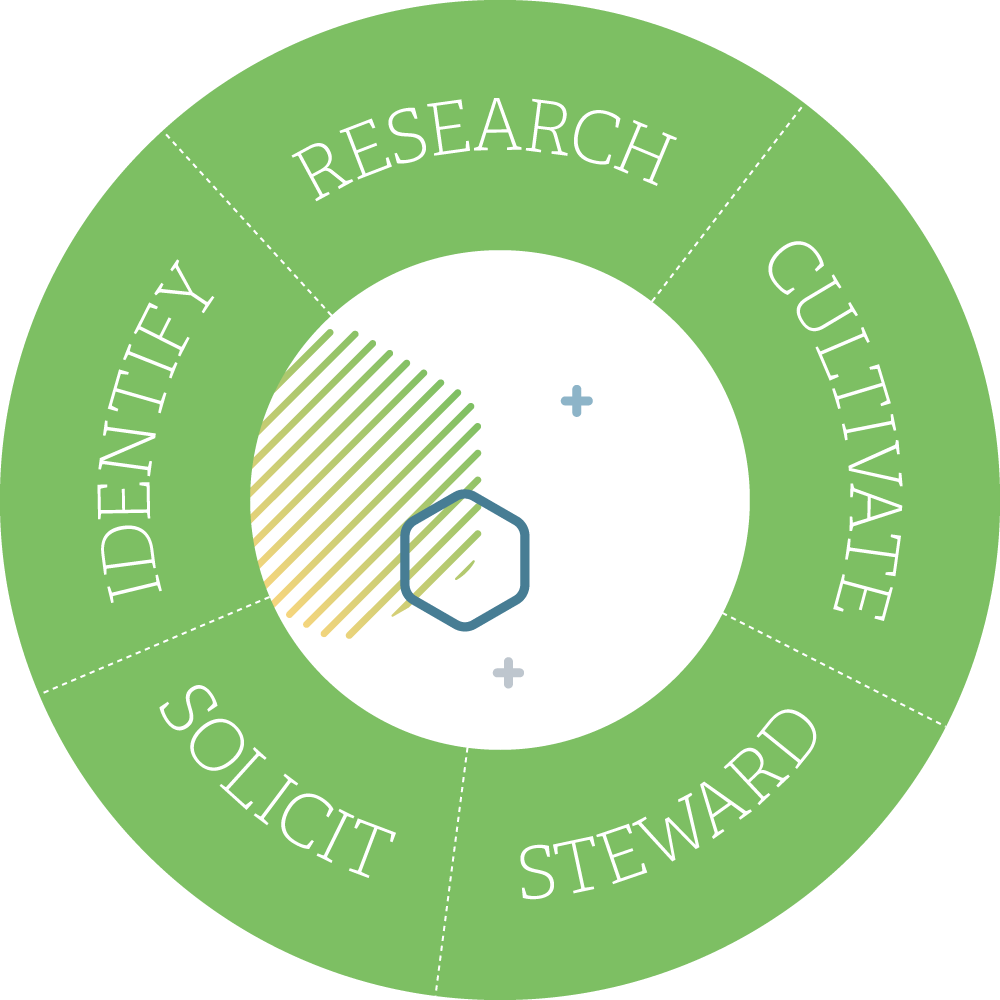
The donor cultivation cycle
The cultivation cycle is the process of identifying and cultivating prospective supporters into donors and previous donors into recurring donors. Once a prospect becomes a donor, make sure to steward the donor to the point that they stay involved in your organization. Stewardship aims to retain your donors so that they remain within the cultivation cycle.
Once your donor has been properly stewarded, they can be cultivated for their next gift. Good cultivation strategies allow you to better understand your donors’ expectations so you can meaningfully engage with them throughout your relationship.
Donor relations
Donor relations are your organization’s comprehensive actions to promote long-term engagement and high-value interactions with your donors. Donor stewardship and donor relations are often used interchangeably, but stewardship is better understood as a subset of donor relations. Donor relations include all of your organization’s communications and relationship-building with your donors, while stewardship’s primary focus is honoring your donor’s gift intentions.
Donor cultivation
Donor cultivation is the process of engaging a prospect and building a relationship prior to your donation ask. This is also used as a broad term referring to the cycle. Cultivation is a necessary aspect of donor relations that focuses on understanding how your donor’s wants align with your organization’s needs. Cultivation and stewardship are similar, but stewardship centers around your donors and cultivation centers around prospects.
Donor retention
Donor retention is a part of the stewardship process that helps you keep your donors involved once they have given to your organization. Donor retention ultimately means your donors give more than once to your organization. At the same time, stewarding your donors is a key strategy for retaining them long-term because stewardship is about furthering your relationship.
The donor stewardship process
Step 1: Your nonprofit receives a donation
Stewardship begins when your donor makes a gift to your organization. Who your donor is and how much they give determines your stewardship strategy. For example, a major donor who frequently gives to your organization requires different stewardship techniques than a surprise mid-level donor with no prior ties to your organization. Use this early stage to add new donors to your donor database or update your current donor profiles based upon the gift and its timing.
Step 2: Thank your donor for their gift
Once your donor gives, the first thing you should do is thank them for their generosity. It’s important that you thank your donors before moving forward. Gratitude shows that you appreciate their donation. This initial thank-you, like all others, should be personal and sincere, but it’s only the beginning. Think of this thank-you as a starting point in a more involved process. And always thank your donor with their preferred name and title, regardless of the size of the donation, and use their preferred methods of communication.
Step 3: Confirm your donor’s intentions and expectations
If you’ve been properly cultivating your donors, you should have an understanding of your donor’s expectations before you solicit a gift. This step is a chance to confirm your donor’s intentions with their gift or find out about the motivations of a new donor you have yet to cultivate a relationship with. Provide your donors with giving levels so they can see the impact of their donation and match your stewardship to your donor’s level of giving.
Your nonprofit’s job is to manage your donors’ expectations within the realm of their gift size and your nonprofit’s capabilities. Further, the better you understand your donor’s intentions, the better you can manage their gift so their funds help the cause they most care about.
Step 4: Recognize your donor accordingly
Recognition can be public or private and can encompass anything from an invitation to a private dinner to an engraved plaque to a simple post on social media, depending on the donor and their gift.
This step requires a great understanding of who your donor is as a person. Some major donors, for example, may love to be put in the public spotlight while others would cringe at being thanked in a crowded room, so ask permission before recognizing donors publicly.
It’s also important to understand that recognition should not be reserved for your major donors alone. Smaller gestures can be effective for new, low, or mid-level donors, such as an opportunity to sign a banner at an event or a mention in a fundraiser program.
Step 5: Report the gift’s impact to your donor
Why do your donors give to your nonprofit? To help the people, animals, or communities that they care about. Reporting on your donors’ impact is vital to fulfilling their expectations. Your report should be specific, yet emotionally driven. For example, you could send an update featuring a recipient of your aid. Include a picture of this person and explain how your donor’s gift directly resulted in positive change for this person.
Reports should also be governed by the gift. It would be appropriate to call a major donor to update them personally on how their donation built a new home for a family in need or even take them to the worksite! Your new and smaller-gift donors deserve to see the impact of their gifts just as much, but in these cases, sending emails or posting a mass update on social media can be a simpler way to show them how they’re making a difference.
Step 6: Begin the cultivation process
Once you’ve properly stewarded your donor, they should feel appreciated and understand how vital their contributions are to helping people in need. Now, you need to begin cultivating them for their next gift. A strong stewardship process should help you retain your donors and grow their giving levels. Remember: The stewardship process can take many months, and cultivation can only begin once a donor has been thoroughly and properly thanked, recognized, and updated.

Donor stewardship techniques
1. Process gifts quickly
Once your organization receives a gift, immediately confirm that the donation has been received and work on implementing the gift in a timely manner.
Send donation receipts ASAP so that your donors know their gift has been received. Most online giving software can automate this process. The more personal your receipts are, the better your donors will be able to understand the impact of their gift. For example, a receipt that thanks a donor for their contribution to a specific campaign shows that your organization is putting the gift toward its intended purpose.
2. Tell a story
Nonprofit storytelling involves showing how your donor’s gift has impacted the life of a specific person, community, or animal that your nonprofit supports. Make your donors the hero of the story by showing how their gift has helped.
Write thank-you letters that focus on your donor and the people that they want to help. Use donor-centric language, using “you” at least twice as much as “we.” Structure your letter so that you introduce the recipient(s) of your nonprofit’s aid, explain how your donor helped them, and allow the recipients of your nonprofit’s work to speak for themselves.
3. Create giving societies
Creating exclusive memberships incentivizes your donors to give more to your organization and stay involved with other donors who care about your nonprofit’s work.
Donors who give a certain amount or pay an annual membership fee can be invited into your giving society. The giving society should hold special perks for members, such as free parking at events or exclusive promotional items. But ultimately, your giving society should focus on a community of philanthropy.
4. Host stewardship events
Hosting stewardship events allows you to thank your donors in person and demonstrate what being a part of your organization can mean.
Invite specific groups of donors to your events. For example, you may host a major donor gala or a mid-level donor cookout. Focus on gratitude, and do not ask for more donations, but demonstrate your appreciation with a special video reel or a speech from a recipient of your nonprofit’s aid. Bringing your donors together can motivate them to stay invested.

Donor stewardship program roles and responsibilities
The roles and responsibilities involved with donor stewardship will vary depending on the size of your organization. Some organizations will integrate stewardship efforts into other donor relations roles, while others may have a separate stewardship department that manages and reports on donor funds.
Director of Donor Relations
Depending on the size of your nonprofit, your director of donor relations may be fully responsible for your donor stewardship program as well as other donor relations programs, or they may maintain a broader role in which they oversee your program and your stewardship officer.
Your director of donor relations keeps everyone focused on the primary goal of building stronger donor relationships.
Stewardship Officer
Your stewardship officer is a vital player in pulling together donor stewardship profiles, ensuring your donors are properly thanked, creating stewardship reports, updating stewardship processes, and maintaining your stewardship schedule.
Your stewardship officer not only maintains your program but helps it grow. Your officer will work with your major gifts officers, board members, and committees to ensure that stewardship is being properly executed.
Major Gift Officers
Your major gifts officers will play a key role in your stewardship efforts because they build relationships and trust with major donors. They’re in charge of your in-person or written communications with your major donors, and they can help implement and execute your stewardship program.
Stewardship should stem organically from your cultivation efforts. Your major gifts officers spend a lot of time with your major donors, so a solid stewardship program should integrate them into your overall plan.
Board Members
Board members are the face of your organization. They’re used to recognize your donors and demonstrate their appreciation for the gifts your nonprofit has received. Signing letters or even meeting with high-level donors are part of your board’s responsibilities.
Donors tend to respect the position of board members, so leveraging your board members to show your nonprofit’s appreciation is a highly effective means of cultivating long-term donors.
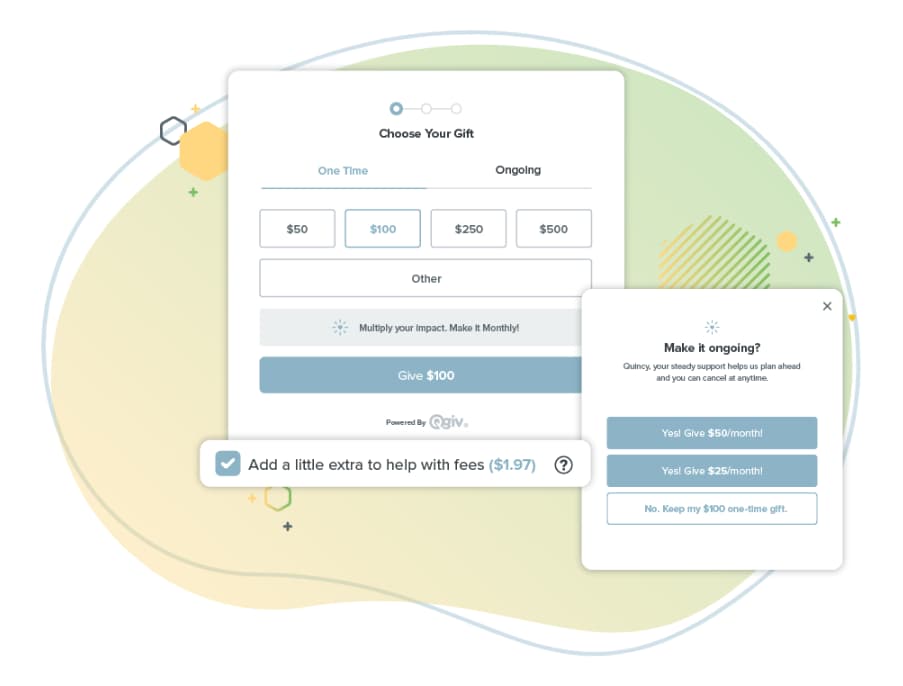
Donor stewardship tools
These essential resources for successful donor stewardship, encompassing elements such as online giving software, donor stewardship matrices, mobile giving strategies, and donor databases or CRMs, will play a pivotal role in cultivating strong relationships with your supporters.
Online giving software
Strong online giving software allows you to set up donation pages on your website, receive and process donations easily, automate donation receipts, and capture donor information. An online giving platform is useful for collecting donor information and setting their stewardship expectations.
For example, you can provide multiple giving options on your online donation forms, and with each option, explain how those funds will be used to further your mission (ex: $50 will feed a child for a month). That way, your donors can anticipate the nature of your updates and feel satisfied that their funds were used as your donor intended.
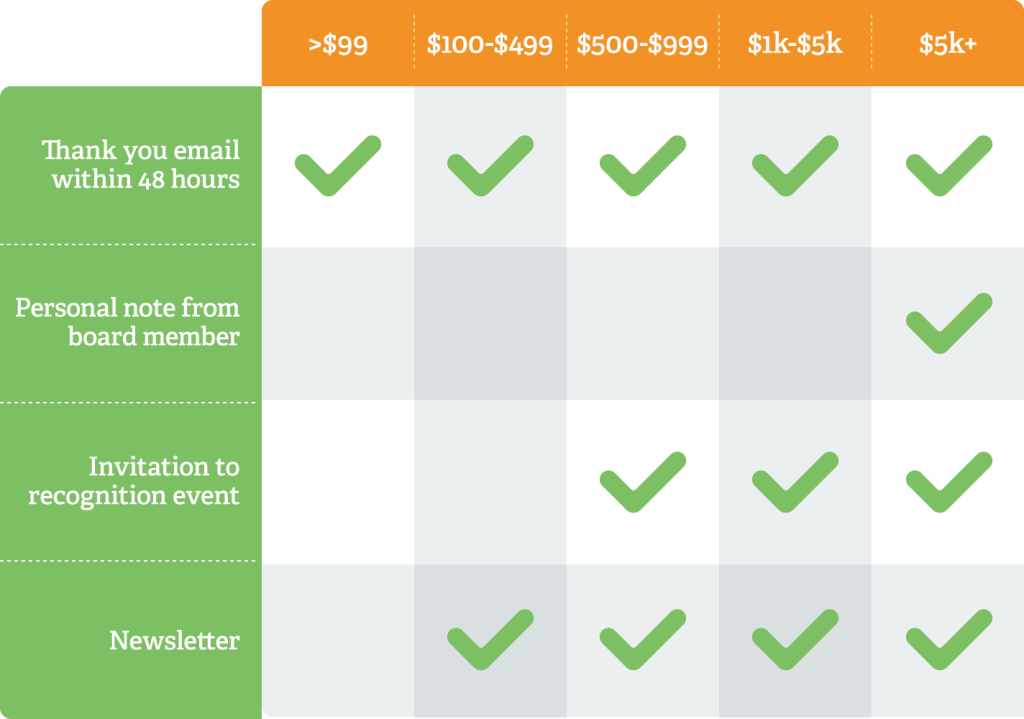
Donor stewardship matrix
A donor stewardship matrix is a tool that charts your general stewardship actions based upon a donor’s giving level, which is great for enhancing your annual fund strategy. Segment your stewardship matrix based on your target donor groups and make it as granular or as general as your nonprofit needs it to be.
A matrix can be created in Excel and be used as a systematic method of determining which donors receive which kind of stewardship. However, remember that a stewardship matrix helps your nonprofit approach donors as groups, not as individuals. You still need to reach out to donors on a personal level.
Mobile fundraising tools
Mobile giving helps you steward your donors because of its convenience. Most people use mobile devices for one purpose or another—optimizing your giving pages and nonprofit’s website for mobile helps you reach your donors where they already are.
Introducing your donors to mobile technologies like text fundraising can help you cultivate your donors into frequent givers. Frame the conversation around your gratitude and how you want to make giving easier for your loyal donors!
Donor database or CRM
Many organizations will want to invest in a donor database or CRM to streamline interactions with donors through donor profiles, especially now that there are more options available to nonprofits of all sizes. Donor databases are a comprehensive means of tracking relations with your donors, recording data, and segmenting your donors into key groups.
Smaller or newer nonprofits may choose to seek out calendar software to keep track of their stewardship efforts rather than investing in a full-fledged donor database. Calendar software can be used to schedule specific stewardship meetings, events, and interactions.
However, more and more nonprofits are switching to a dedicated CRM, especially since there are now CRMs available at every price point and feature level. Even HubSpot offers a free CRM option for nonprofits!
Donor stewardship plan guidelines
Create a policy
Your donor stewardship policy will guide your interactions and communications with your donors. Your policy should clearly state the role of stewardship in your organization and should be accessible to any donors, potential or otherwise.
A stewardship policy states your organization’s intentions and abilities upfront, so that your donors know what to expect when they give. A strong stewardship policy will keep your organization on track and curb potential disappointment from donors.
Focus on the mission
Your mission is the most important aspect of your stewardship. In your communications and reports, always focus on how your donor furthers your mission and helps people in need.
Even though you can use promotional items or events to keep your donors engaged, these fun elements shouldn’t be the focus of your stewardship. Grounding your stewardship efforts in your cause keeps your interactions meaningful. The last thing you want to do is appear superficial to your donors!
Respond personally
No matter who your donor is or how much they’ve given, always be personal when it comes to thanking them for their contribution and following up with updates.
Be sure that all donors are recognized for:
- Their donation.
- The specific campaign that they donated to.
- The overall mission that they’ve furthered.
Always thank them by their preferred name and in their preferred channel. The better you know your donors, the more you can craft your stewardship to their preferences.
Engage donors as active agents
When it comes to engaging your donors, treat them like the active, impactful donors that they are. Center your engagements around your mission and how your donors play a role in furthering your cause.
Engagements can include physical opportunities for your donors to visit event sites or meet board members, and also include simpler gestures such as asking for their feedback or opinions on your programs. It’s essential to recognize your donors not just for their financial support, but for their investment and active contributions to philanthropy.
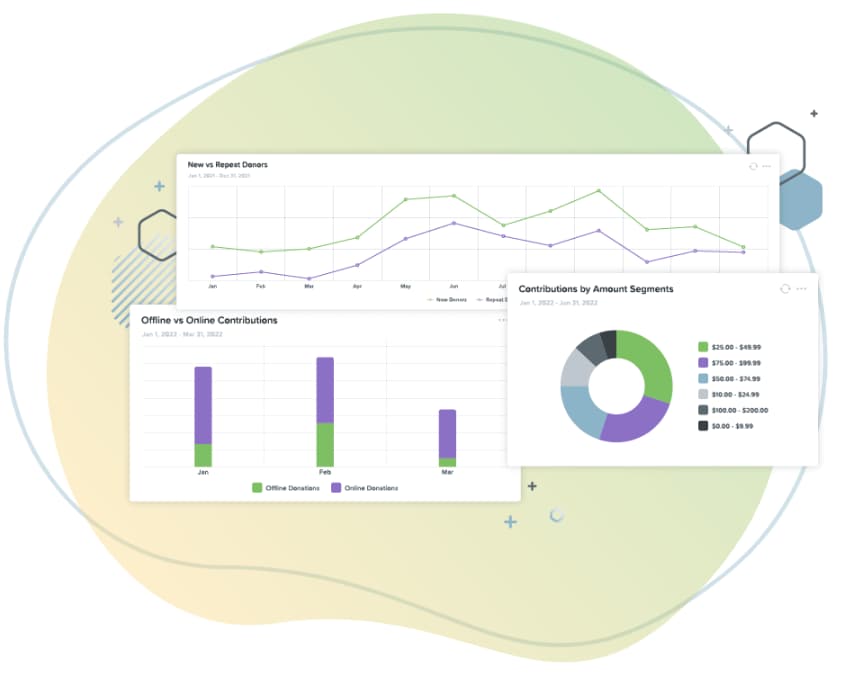
Creating a stewardship plan
1. Segment your donor database
Donor segmentation allows you to create the most meaningful and relevant stewardship strategy by grouping them based upon specific traits. You can segment the entirety of your database, or you can focus on specific groups of donors, such as the attendees at your latest event. How you segment your donors will determine how you communicate with them and how often.
How to do it:
Set a goal and segment your donor database accordingly. For example, if you want to focus on moving your donors up the donor pyramid, segment them by gift size. Then, create your stewardship matrix based upon the groups that you’ve chosen. You may also need to segment your donors further in each group. For example, some major donors may prefer in-person communications, while others may prefer mail.
Segment your donors by these categories:
- Gift frequency
Knowing how often your donors give can help you create a stewardship schedule that will most appeal to their generosity.
- Communication
Understanding how your donors prefer to communicate can help you reach them most effectively.
- Demographics
Factors such as age and gender can indicate how your donor may respond to your communications. Every donor is different, so use demographics as guidelines.
- Average gift size
The most common segmentation, average gift size, can be granular ($5,000) or general (mid-level donor).
2. Create a stewardship calendar
A donor stewardship calendar encompasses your plans for the year. Your calendar should be guided by your donor segmentation and can also include your matrix tool. Your nonprofit’s stewardship calendar helps you create targeted communications and engagement opportunities that have an impact.
After all, too many stewardship communications can annoy your donors, while too little can leave them feeling unappreciated. This sample donor stewardship calendar (template) will help you get started!
How to do it:
Begin planning your outreach around any annual events or fundraising campaigns that are already scheduled. You don’t want to overlap an ask with a recognition letter. You also need to account for year-end fundraising when organizations traditionally ramp up their fundraising appeals. Once you’ve blocked out time for these major fundraising opportunities, schedule your stewardship sparingly, over multiple communication channels throughout the rest of the year.
You’ll need to schedule:
- Outreach
Outreach includes updates or communications (such as birthday cards) you send to donors. You want to inform them about the status of your mission and the impact of their support without asking for donations.
- Stewardship events
Stewardship events are your chance to recognize your donors in person. Events can vary from casual outdoor cookouts to formal major donor galas. Knowing your donors’ preferences can help you plan the best possible event.
- Recognition programs
Recognition programs publicly thank donors over certain intervals. These programs can include newsletters or social media posts, for example. Scheduling in advance helps you provide updates regularly.
- Goals
Setting goals for your donors is important, but knowing when you’d like to complete these goals is vital to assessing your stewardship program. Create a rough schedule to keep your stewardship efforts on target for your goal deadlines.
3. Craft a donor communications strategy
Your communication strategy should include everything from thank-you letters to follow-up reports. Having a strategy in place allows you to plan your communications so that you keep donors engaged without bombarding them.
Your communication strategy should be coordinated to your donor segmentation, but make sure each and every donor receives something personal and meaningful.
While it’s important to create guidelines for your general communications with different donor groups, consciously strive to make genuine connections with your donors. Consider having your officer send a postcard from a place that a major donor has mentioned wanting to visit, for example.
How to do it:
Though strategies will vary depending on your organization, take a look at some best practices that apply to all donor groups:
- Donor-centric language: Focus on what your donor has accomplished with their donation. The word “you” should appear at least twice as much as “we.”
- Relevant and specific: For example, a new donor should receive a communication that welcomes them to your organization. On the other hand, a donor who has given for many years but who has increased their gift size deserves recognition for their continued and growing support.
Your strategy should also include a general schedule so you can send out holiday cards or seasonal appeals.
Connect with donors using:
- Social media
Social media is a great way to publicly recognize your donors and show them what their gifts have helped your organization accomplish. Use scheduling tools to consistently post your gratitude for your donors on your social media platforms.
- Direct mail
Send out fliers and thank-you notes to your supporters using direct mail. While online communications are increasing, direct mail is still a great way to add some personal touches to your donor experience.
- Phone calls
Give your larger donors and long-time supporters a special phone call to thank them for their support of your cause. Use these calls as an opportunity to answer any questions your donors have about specific projects and campaigns.
- Emails
Email helps your nonprofit stay in constant contact with your supporters. Automate thank-you letters to be emailed to your donors after they donate and schedule an email newsletter for your supporters to stay updated on current projects.
- In person
Talking to your donors in person helps them make a more personal connection to your organization. Humans are naturally drawn to each other, and in-person conversations make your nonprofit more relatable.
4. Determine donor engagement opportunities
Engaging your donors is one of the best ways to keep them invested in your organization.
Tailor activities specifically for donor stewardship, only inviting high-level donors, or put a stewardship spin on your general events and activities by recognizing your donors with perks. The point is to get your donors interacting face-to-face with your organization, so you can create a deeper relationship with them.
How to do it:
Understanding your donors helps you craft tailored experiences that you know they’ll love.
To start out, grow your stewardship plan organically from your nonprofit’s events and activities. For example, if you host an annual walkathon, create a VIP space for your mid-level and major donors. This can even be done with virtual and hybrid events! Then, begin creating stewardship-centric events. Send out surveys to find out what kind of event appeals to your donors the most.
You can engage your donors with:
- Personal invites
Personal invitations to your annual events are an effective way to show your donors that you value their presence in your organization. Use their preferred names and recognize their previous support.
- Exclusive events
For major donors or people with memberships to your organization, host exclusive events that give them access to the leaders of your nonprofit. These small events foster a sense of community within your organization and encourage continued support of your cause.
- Articles of interest
Officers with a lot of knowledge of your donors’ interests can send them the occasional article that they’d enjoy. Doing so shows a personal interest in your donors and can start a valuable conversation.
- Volunteer opportunities
Create special volunteer opportunities so your donors can experience your nonprofit’s work firsthand, allowing them to see how your organization helps from behind the scenes.
- Fellowship activities
During stewardship events, in VIP areas or in membership programs, give your donors the opportunity to build bonds with other donors. Facilitating conversation and fun activities keeps your donors engaged with each other.
5. Create a system of recognition
When it comes to recognizing your donors, a strong system ensures that no donor goes uncelebrated. Lay out clear guidelines for which donors receive what kind of recognition based on your donor segmentation.
Of course, recognition should still be in line with the donors’ preferences, but general guidelines help you make sure all of your donors feel appreciated. Further, a system of recognition helps your donors manage their expectations around what your organization can reasonably provide so they can anticipate what kind of recognition they’ll receive.
How to do it:
Recognizing your donors means creating a program that relies on both tradition and innovation, as traditional recognition can be very meaningful to long-time contributors. Survey your high-level and recurring contributors to find out what kinds of recognition have meant the most to them.
At the same time, introduce fresh ideas into your recognition programs so that every donor feels personally celebrated. For example, incorporate your donors’ personal thoughts, pictures, or contributions into your recognition efforts.
Recognize your donors with:
- Donor walls
Allow your donors to sign a wall or engrave high-level donors’ names into a designated space to give your donors a visual legacy at your organization.
- Honor rolls
Honor rolls list major donors based on their giving levels. They are often incorporated into print publications, especially for event brochures.
- Donor profiles
Press releases or other “featured donor” publications and posts can recognize a special contributor to your organization and tell their story.
- Naming rights
Name building projects or in-kind donations after your donors who have made those donations or who’ve contributed substantially to preserve their legacies.
6. Evaluate donor data
Donor stewardship is meant to help you increase your funding and donor retention rates, so you need to track your efforts to ensure you’re on the right path to avoid wasting time and resources. If your donor stewardship efforts aren’t helping you reach your goals, they might be costing your organization money instead of raising it. Your stewardship calendar will help you track your goal progress.
How to do it:
Before you start, decide how frequently evaluating your donor data will be helpful to your nonprofit. Analyzing data too often may not give you an accurate picture of your progress, and analyzing too little won’t give you any room to change your donor stewardship tactics to meet your goals. Look into your information once every month or so to see what’s working and what’s not.
Evaluate your data by:
- Surveying donors
Donor feedback is incredibly helpful for understanding your donors. Send out donor surveys asking your supporters for communication preferences, donation experience feedback, and general recommendations they have for your nonprofit.
- Tracking donation increases and retention
One of the easiest ways to measure your donor stewardship levels is by looking at the numbers. Your fundraising software keeps data on your donors to let you see if there have been increases in donation amounts or recurring donors to your organization after you’ve implemented your donor stewardship efforts.
- Analyzing how you segment donors
Segmenting your donors helps you determine the best strategies for each donor demographic. Looking at how you’ve segmented your donors shows you in which groups your goals are being met and which groups need different stewardship or segmentation. For example, if a specific segment is not seeing any fundraising increases, consider redefining the parameters of the segment.
- Using a CRM to track stewardship efforts
Nonprofit CRMs both automate and organize your communication efforts with your donors. If your nonprofit uses a CRM, you can track your different stewardship efforts and see which campaigns performed the best to repeat their success.
Final thoughts
Creating the best donor stewardship plan for your nonprofit is an ongoing process that requires tweaks along the way. If you’d like more data and resources to help you create fundraising plans that will guide your organization through any situation, download a copy of Navigating the Unknown. This report is full of data and feedback from nonprofits and donors around the country which will help you plan your fundraising campaigns with confidence.
Additional resources
- Cultivating Donor Retention to Grow Your Giving Garden: Donor acquisition, on average, costs 10 to 20 times more than renewing your donors’ support. This eBook will help you save time and money by focusing your efforts on donor retention!
- Retaining Your P2Peeps: Retaining your peer-to-peer participants and donors between events helps your nonprofit obtain stable sources of revenue for years to come.
- Digital Fundraising Guide: Ideas and Steps to Reach Your Goals: If you’re looking to learn more about digital fundraising or want to keep up on emerging trends, this eBook will walk you through the process of choosing the right digital fundraising solution for your nonprofit’s specific needs.





